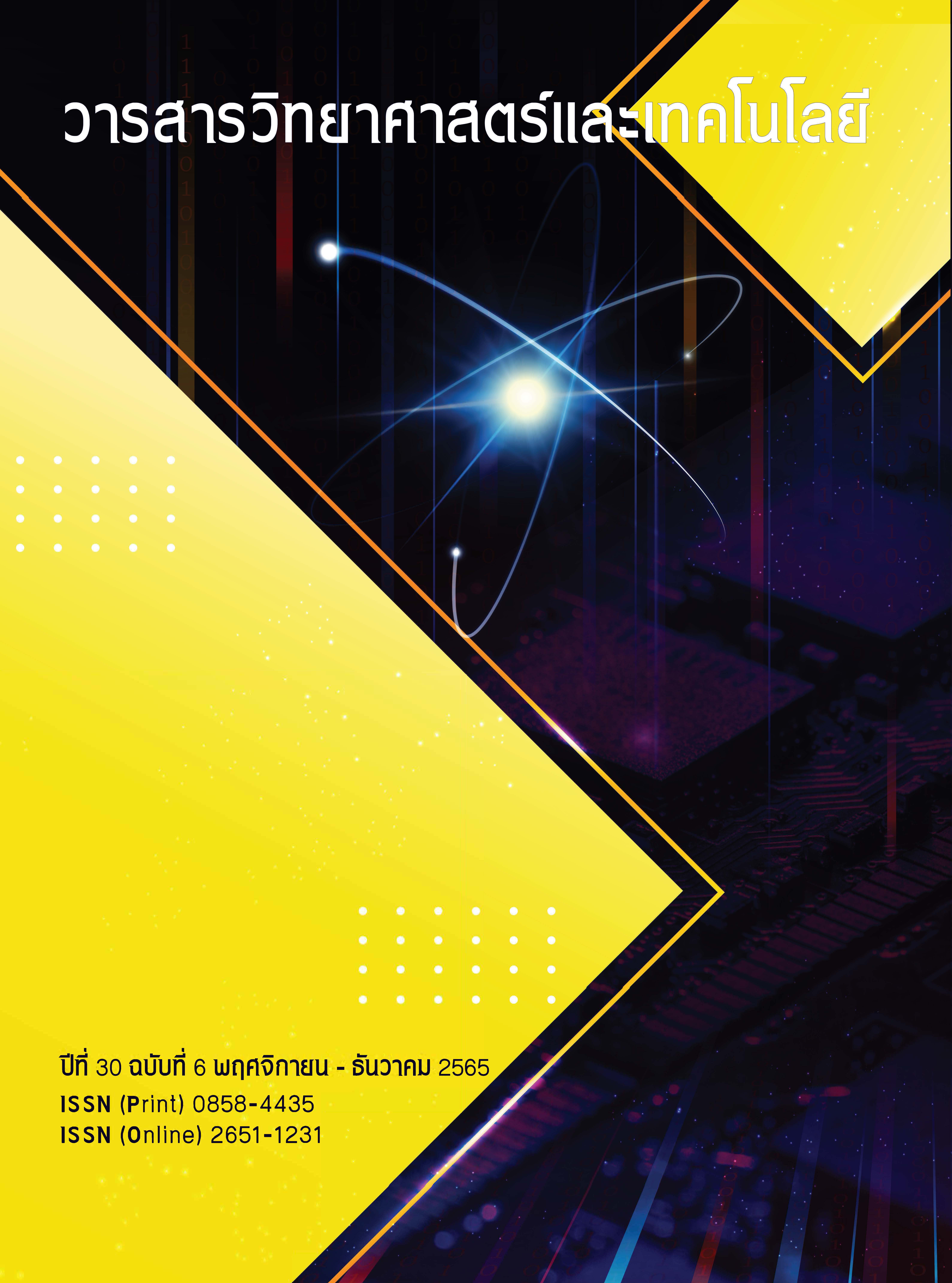Effect of Cutting Styles on Quality of Fresh-Cut ‘Khai Tuek’ Mango Fruit
Main Article Content
Abstract
Mangoes are an important economic fruit crop in Thailand. Currently, consumers prefer to consume it in the form of fresh-cut products. However, a problem of quality change on the cutting develops during distribution and affects consumer acceptance. Therefore, this research aimed to study the cutting styles on the quality change of fresh-cut mango during storage. The experiment was conducted in a completely randomized design (CRD) with four treatments and six replications. The mature-green mango fruits (average 300 g/fruit) were cut into cross-cut, longitudinal-cut, slices and whole fruit (without cutting) as control, then packed in Polypropylene (PP) plastic trays and stored at 8±2 ºC for 10 days. It was found that the longitudinal-cut fruit delayed the quality change of the fresh-cut mango, and effectively maintained hue value, carotenoid content, and browning score compared to other cutting styles. However, the total soluble solids and titratable acidity of all treatments were not statistically significantly different. The longitudinal-cut type maintained quality and delayed flesh browning of fresh-cut mango for up to 6 days, while other cutting styles had only 4 days.
Article Details
References
National New Bureau of Thailand 2022, Thailand Now Stands as 7th World’s Top Fresh Mangoes Exporter, Available Source: https://thainews.prd.go.th/en/news/detail/TCATG220425103510166, September 17, 2022. (in Thai)
Shahidi, F., Janitha, P.K. and Wanasundara, P.D., 1992, Phenolic antioxidants, Crit. Rev. Food Sci. Nutr. 32: 67–103.
Lauricella, M., Emanuele, S., Calvaruso, G., Giuliano, M. and D’Anneo, A., 2017, Multifaceted health benefits of Mangifera indica L. (Mango): the inestimable value of orchards recently planted in Sicilian rural areas, Nutrients 9(5): 525.
Murakoshi, M., Nishino, H. and Satomi, Y., 1992, Potent preventive action of alpha-carotene against carcinogenesis: spontaneous liver carcinogenesis and promoting stage of lung and skin carcinogenesis in mice are suppressed more effectively by alpha-carotene than by beta-carotene, Cancer Res. 52(23): 6583-6587.
Ergun, M., 2006, Fresh-cut physiology and factors contributing to the quality of fresh-cut produce, KSU. J. Sci. Eng. 9(2):164-169.
Laurila, E. and Ahvenainen, R., 2002, Minimal Processing in Practice, pp. 219- 239, In Ohlsson, T. and Bengtsson, N., (Ed.), Minimal Processing Technologies in the Food Industry, Woodhead Publishing, Cambridge.
Ngamchuachit, N., 2017, Fresh-cut mango: physiology and critical factors affecting quality, JFTSU. 12(1): 17-34. (in Thai)
Association of Official Analysis Chemists (AOAC), 2000, Official Methods of Analysis of the Association of Official Analytical Chemists, 17th Edited. Inc. Arlington, Virginia: USA.
Arnon, D.I., 1949, Copper enzymes in isolated chloroplasts. polyphenoloxidase in betabulgaris, Plant Physiol. 24: 1-15.
Chimvaree C., Wongs-Aree, C., Supapvanich, S., Charoenrat, T., Tepsorn, R. and Boonyaritthongchai, P., 2019, Effect of sericin coating on reducing browning of fresh-cut mango cv. ‘Nam Dok Mai No. 4’, Agr. Nat. Resour. 53: 521-526.
Hodges, D.M. and Toivonen, P.M.A., 2008, Quality of Fresh-cut Fruits and Vegetables as Affected by Exposure to Abiotic Stress, Postharvest Biol. Technol. 48:155-162.
Toivonen, P.M.A. and Brummell, D.A., 2008, Biochemical bases of appearance and texture changes in fresh-cut fruit and vegetables, Postharvest Biol. Technol. 48:1-14.
Demmig-Adams, B., Gilmore, A. and Adams, W., 1996, Carotenoids 3: in vivo function of carotenoids in higher plants, FASEB J. 10(4): 403-412.
Gil, M.I., Aguayo, E., Kader, A.A., 2006, Quality changes and nutrient retention in fresh-cut verses whole fruit during storage, J. Agric. Food. Chem. 54: 4284–4296.
Ngamwonglumlert, L., Devahastin, S., Chiewchan, N. and Raghavan, V., 2020, Plant carotenoids evolution during cultivation, postharvest storage, and food processing: A review, Compr. Rev. Food Sci. Food Saf. 19(4): 1561-1604.
Yungyuen, W., Vo, T.T., Uthairatanakij, A., Ma, G., Zhang, L., Tatmala, N., Kaewsuksaeng, S., Jitareerat, P. and Kato, M., 2021, Carotenoid accumulation and the expression of carotenoid metabolicgenes in mango during fruit development and ripening, Appl. Sci. 11(9): 4249.
Li, X., Long, Q., Gao, F., Han, C., Jin, P. and Zheng, Y., 2017, Effect of cutting styles on quality and antioxidant activity in fresh-cut pitaya fruit, Postharvest Biol. Technol. 124: 1-7.
Supphachuchai, J., Jitareerat, P., Uthairatanakij, A., Laohakunjit, N. and Renumarn, P., 2016, Effect of cutting on quality and some phytochemicals of fresh-cut mango, Agricultural Sci. J. 47(2) (Suppl.): 521-524. (in Thai)


